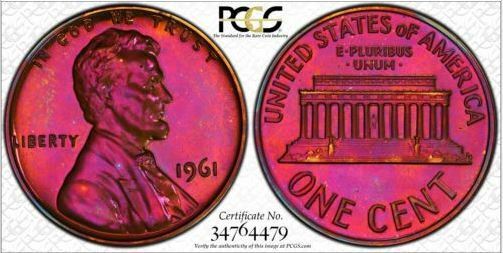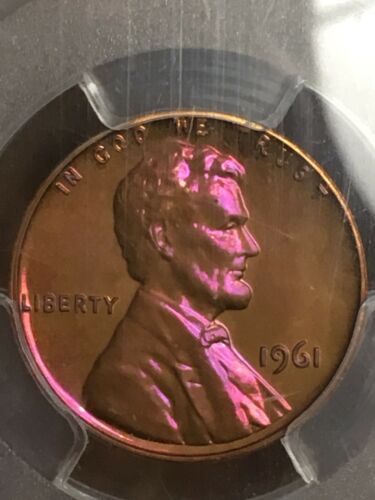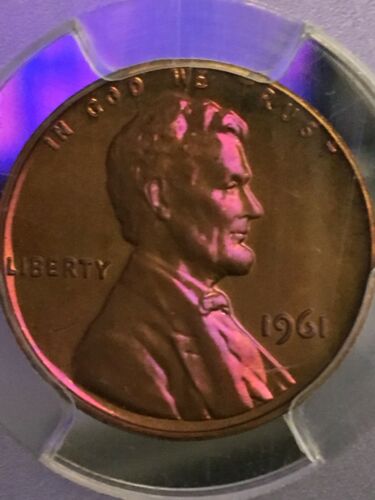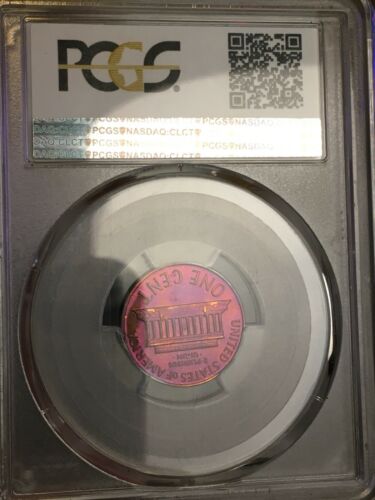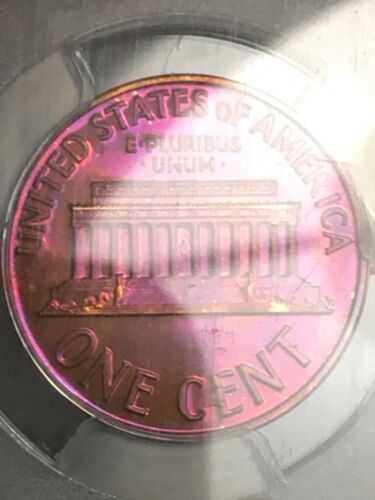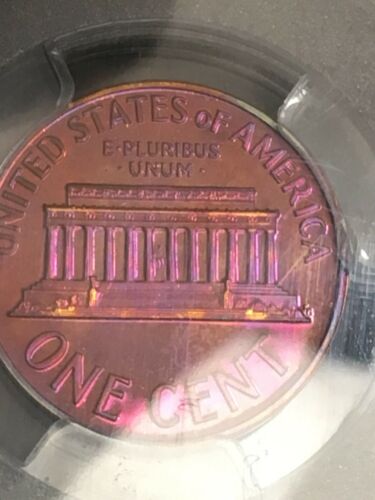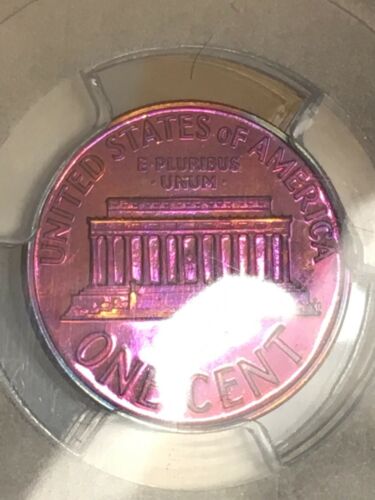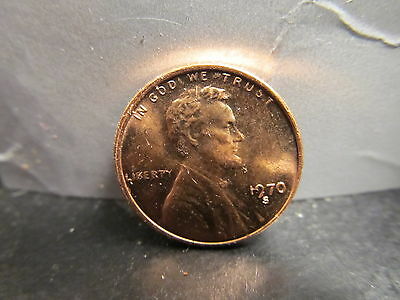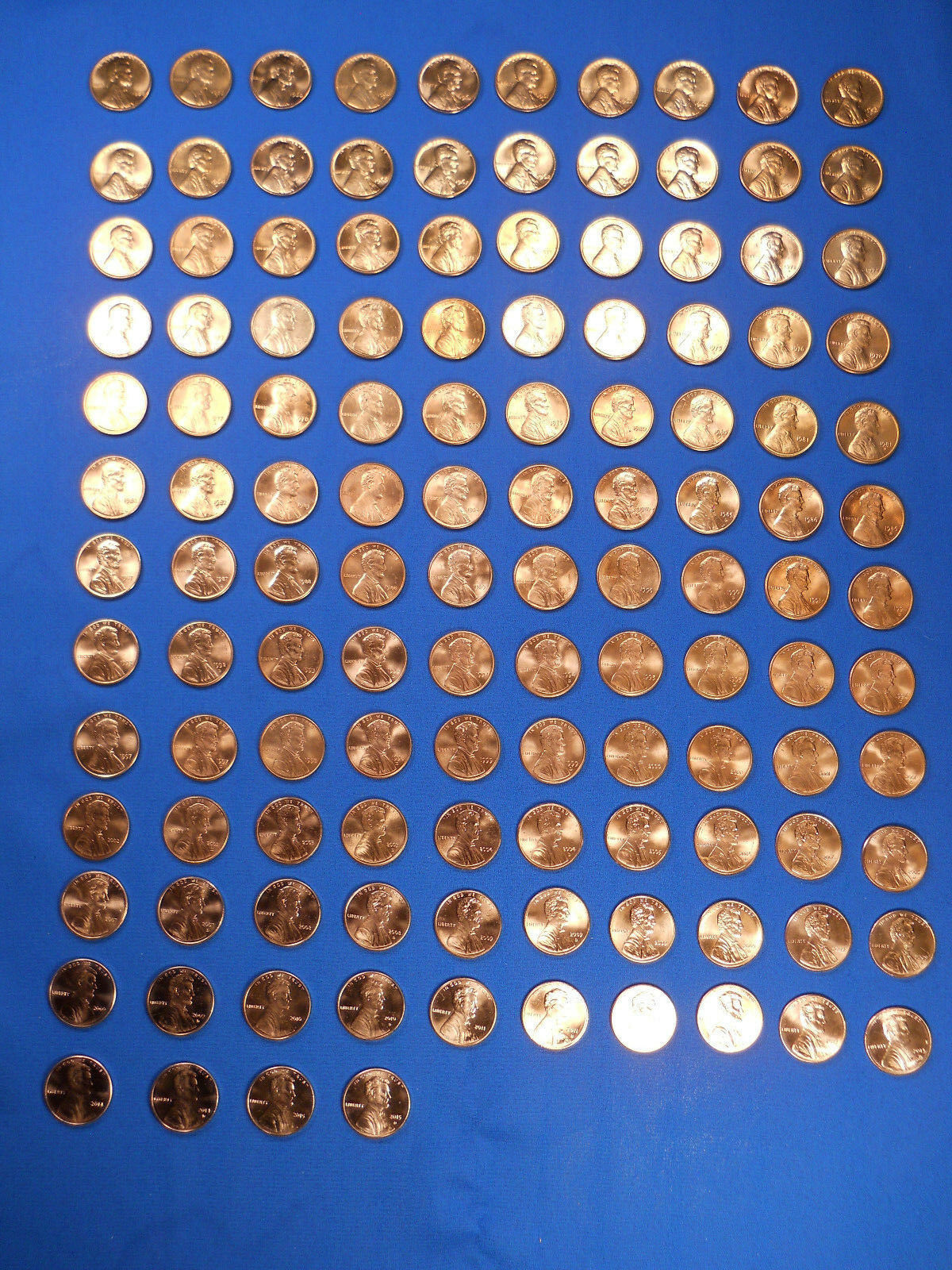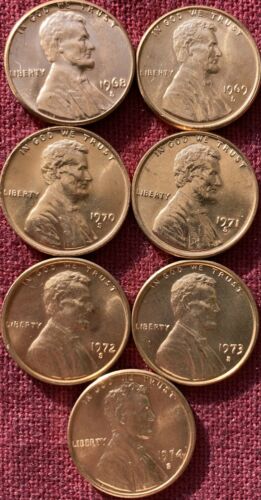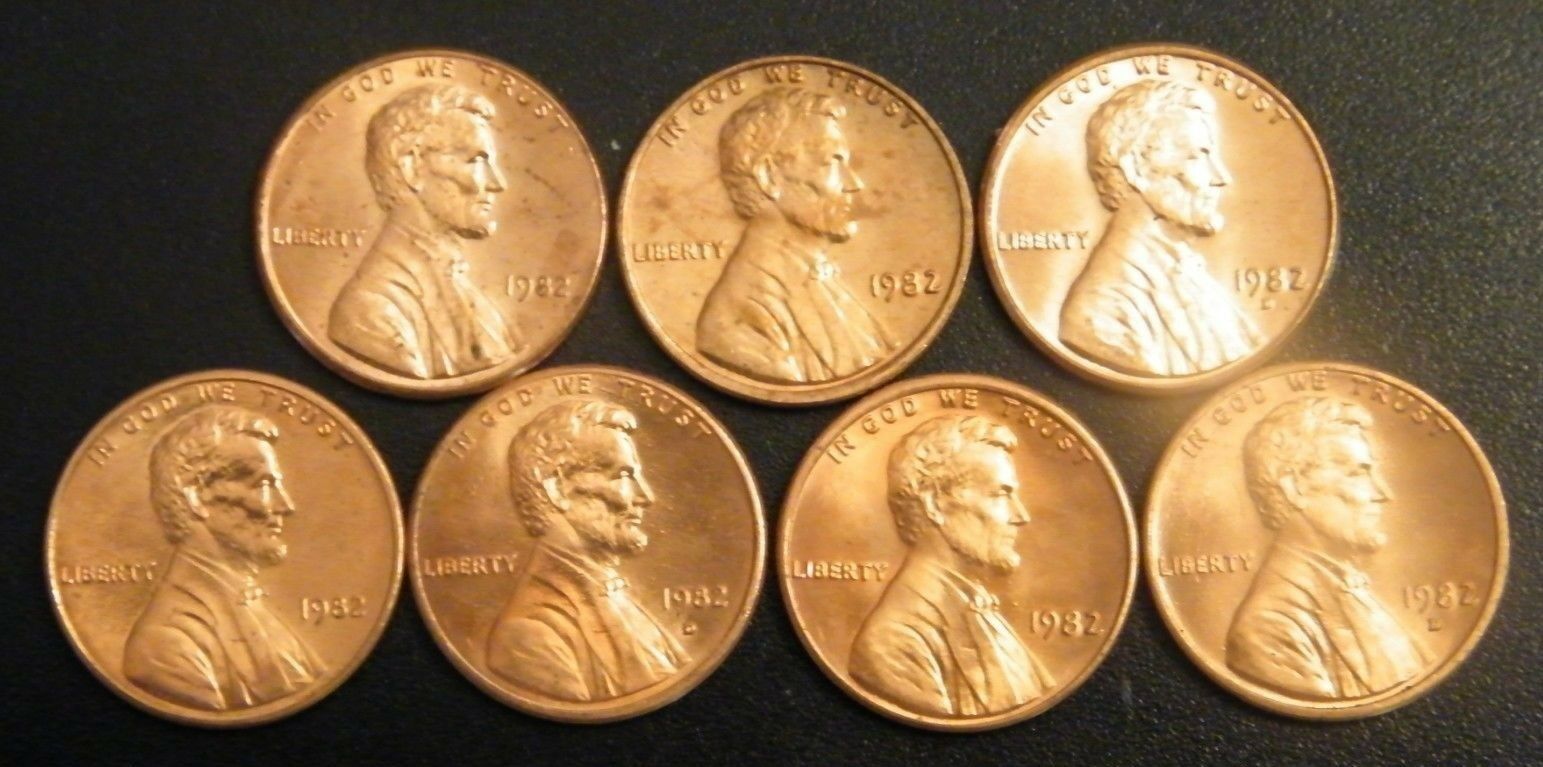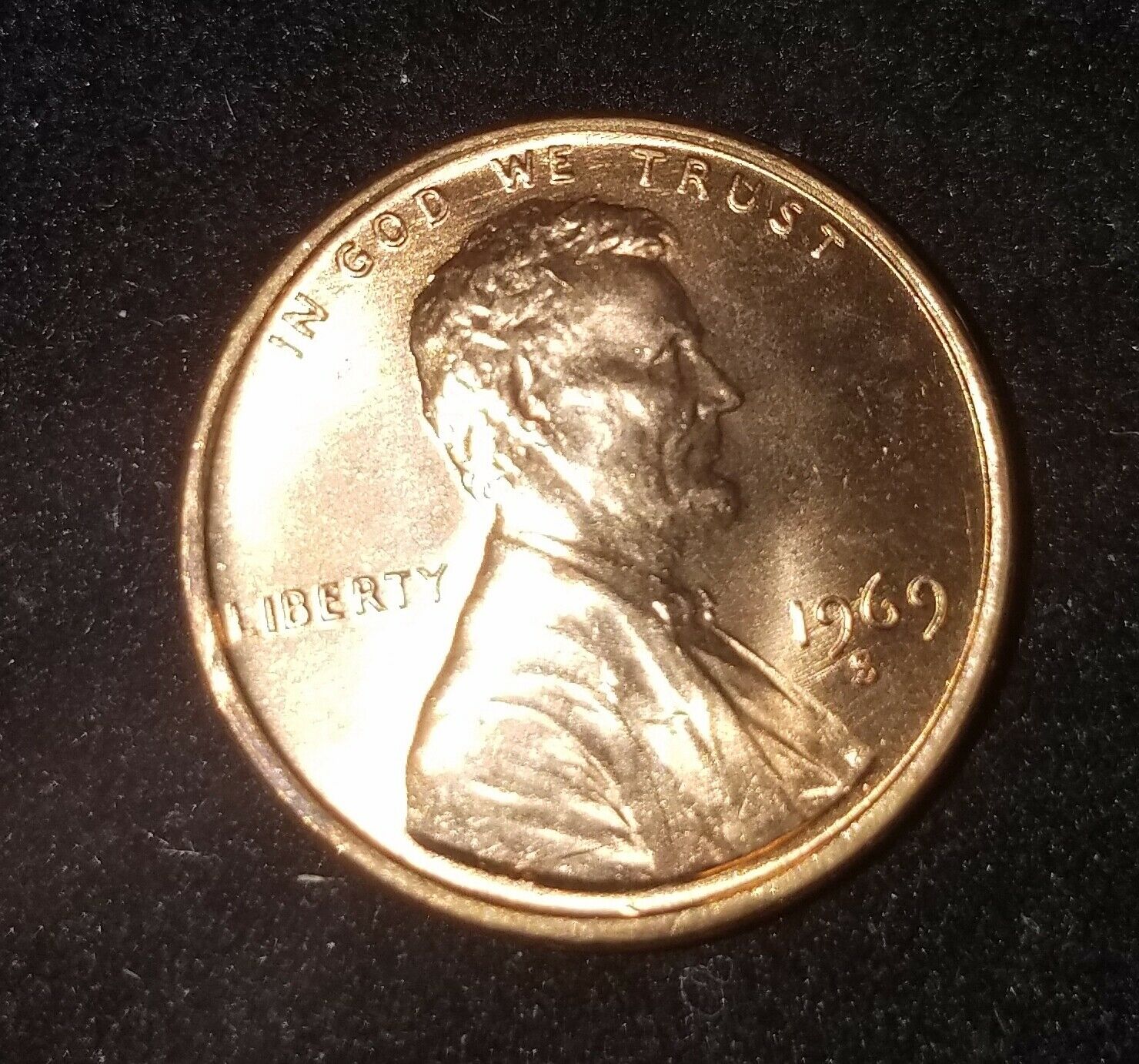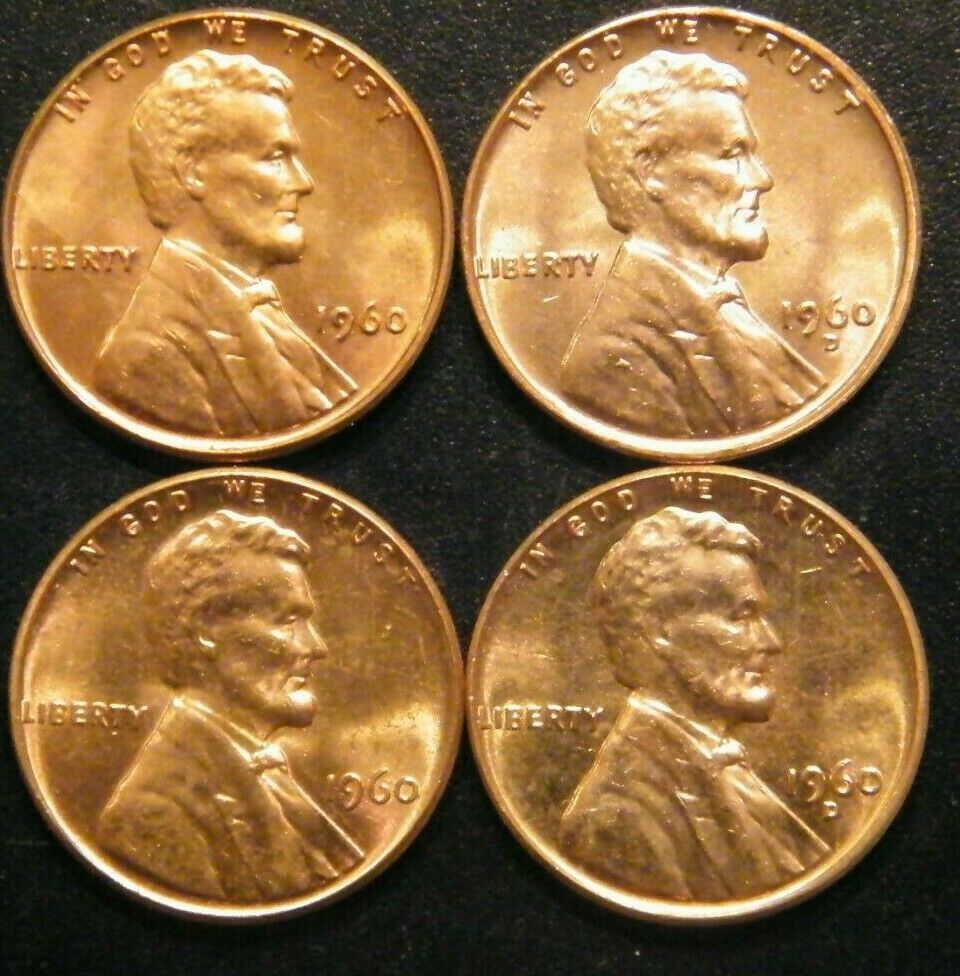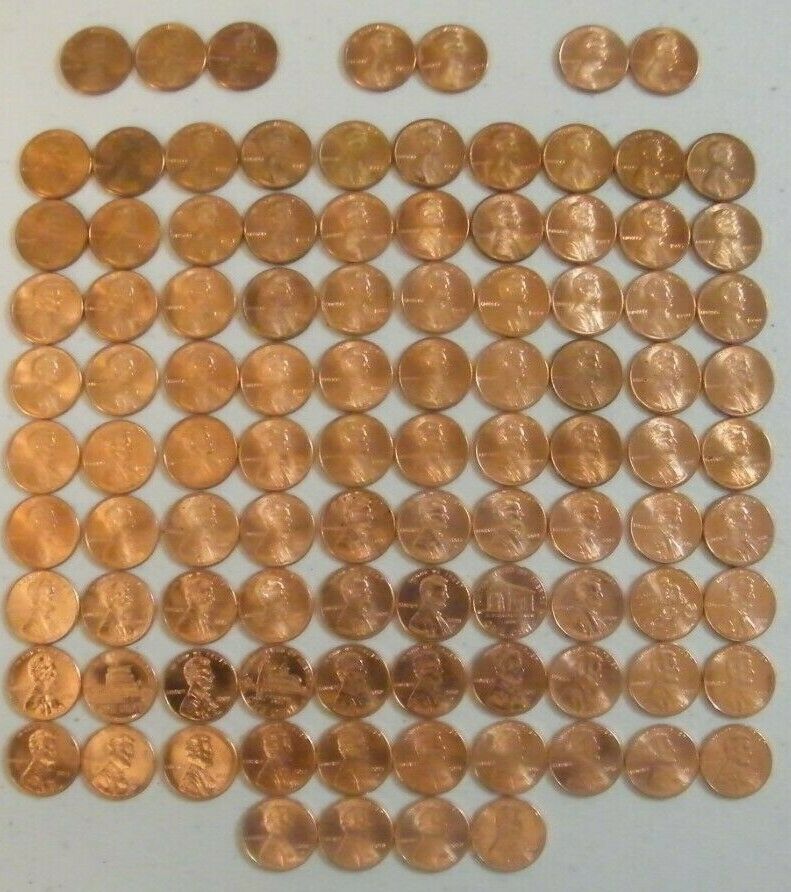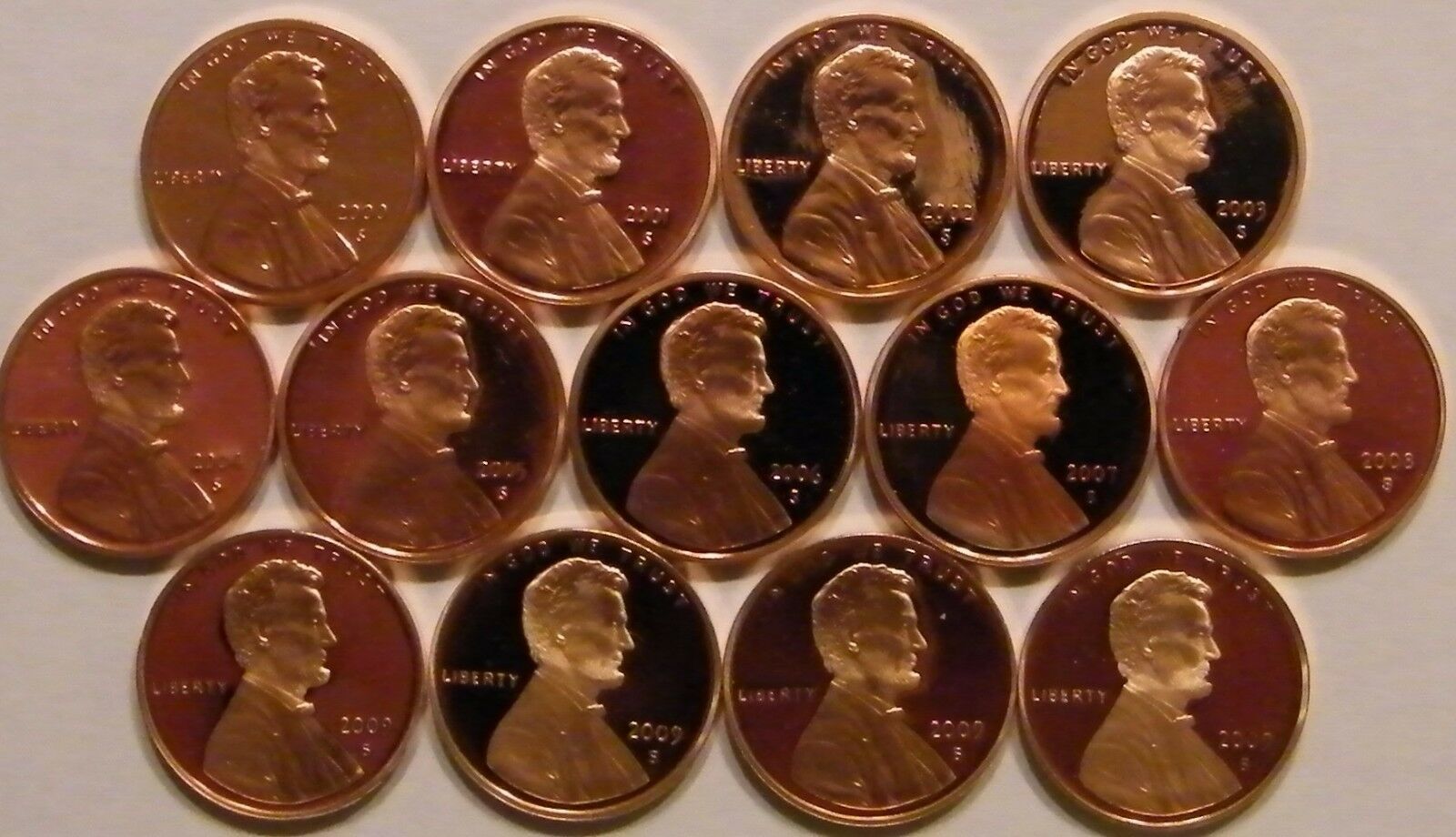-40%
1961 1C PCGS PR67RB Lincoln Amazing Toned Deep Pink - RicksCafeAmerican.com
$ 448.8
- Description
- Size Guide
Description
Rick's Cafe' Ame'ricainUnique Inventory
Hassle Free Returns
Quality Pieces
1961 1C PCGS PR67RB Lincoln True View Amazing Deep Pink - RicksCafeAmerican.com
1961 1C PCGS PR67RB Deep Pink Lincoln Cent
For PCGS only 317 exist with only 93 at this grade, but "money" it's one of the few with this brilliant color certified by PCGS as naturally toned, but a PR67RB designation to boot. In short, this specimen may be one of only a few with this natural Deep Pink toning in existence!
I am selling some of my prized Opalescent Collection, share and enjoy...
A rare Blue beauty!
First, finding a naturally toned coin is a stretch,
Second, finding a naturally toned "Deep Pink" Lincoln cent is off the charts;
Third, Graded at an RB and not the customary BN is extraordinary for an extreme natural Toned Coin.
Finally, getting one that is graded at 67 Certified PCGS PR67RB- forget about it
Who actually buys this one will probably keep it for years...
SOME INSIGHT
Why Toned Coins Command a Premium?Before everyone thinks that paying these prices is crazy, think about some other areas where collectors pay huge premiums. Strike-related features like FH on SLQ's and FB on Mercury Dimes are an example where huge premiums exist.
A 1945 Mercury Dime MS65 goes for about but the FB counterpart is over ,000. That is a 500X premium. Why do collectors pay that premium, because the coin is rare and supply is low. This is the same for naturally toned Coins... We emphasize "naturally", for so many coins out there are "artificially" toned, usually to hide cleaning, or scratches; hence, the importance of third-party certification, and PCGS is one of the best!
In addition, another factor that makes them so rare is that once one hits the market, the person who buys that coin usually takes the coin of the market for many years. The real monsters are so rare that each individual coin is remembered for it's toning. If you say the "Sunnywood 1881-S" to a toning enthusiast, he will immediately know the coin to which you refer. I know it sounds a little far-fetched for collectors to remember specific coins based on their toning, but some coins are toned so beautifully that once you see them they leave a lasting impression.
Certified PCGS PR67RB - naturally toned to beautiful perfection - who actually buys this one will probably keep it for years...
UNDERSTANDING THE COLORED PROOF COINS
For illustration purposes, the total PCGS-graded BN Proof Lincolns for all years (1909-1982), there are only 837.
This is actually an amazingly small population -- roughly 1 BN proof in every 1000 proof Lincoln's graded. Approximately 78% of this small population (655 out of 857) of all the PCGS-graded BN Proof Lincolns for the entire series fell in the Matte Proof Lincoln Era (1909-1916).
The peak year for BN Proofs was 1912 with 127 slabs cataloged, second place was 1911 with 109 slabs. So even though the Matte Proof Lincolns are the rarest in terms of total population for all color classes and have breathtakingly-small original mintages; they are the most common in the Lincoln Proof Series in the ultra-rare BN color class. The reason for the relatively large population of BN proofs in the Matte Proof Lincoln Era is well-known. The Mint wrapped freshly minted Matte Proof Lincolns in tissue paper and placed them in small envelopes before shipping them out during the years from 1909 through 1916 -- and sulfur in the tissue paper, and probably the envelopes as well, accelerated toning over the years, sometimes producing very beautiful colors on the coins surface.
BN’s slowly become more and more common going from 1909 to 1912, reaching a peak population in 1912. Then slowly decreased (except for a slight bump up in 1915) going forward to 1916. The shape of that curve almost makes me think that the tissue paper suppliers might have been changing year to year ... or perhaps the sulfur-content of the tissue paper from a single supplier was varying and reached a peak in 1912. Could that be why there are so many beautifully toned Matte Proof Lincolns in 1912, which is one of the best years in the whole Matte Proof Lincoln series for colorful eye-appealing toning.
It's also interesting that if you combine the 1909vdb and 1909 numbers (since they were produced the same year), then 1916 is by far the lowest population year for Proof BNs in the Matte Proof Lincoln run. My guess is that the tissue paper used by the Mint to wrap Matte Proof Lincolns before being shipped out had little sulfur in 1916. That’s why, I think, it’s practically impossible to find colorful 1916 Matte Proof Lincolns amongst the known examples today.
Following the Matte Proof Lincoln Era, there are only 182 PCGS-graded Proof BNs TOTAL in ALL the years that followed, from 1936-2013.
Sticking out conspicuously on the bar chart is the "monster year" of 1961, which displays an anomalously high population of BN Proofs with a count of 50. So nearly one-third of all the BN Proof Lincolns from 1936–2013 (covering 77 years) are dated 1961 (an interesting statistic). It's also interesting that the 1961 "peak" appears to "drift a bit" into the year 1962, which has a fairly high count of 10 and is the last year the BN Proof count reached double digits.
There are some theories on why this anomaly exists in 1961, one theory was the U.S. Mint was experimenting with some "rinse solutions" for proofs that year, and one of the rinse solution might have caused accelerated toning. Now, that being said, there are many 1961 monster toned proof Lincoln tone inside unopened and undisturbed mint cello, which tends to eliminate most enviromental factors. Also there is no corresponding toning spike in Business Strike 1961 Lincolns, which eliminates the theory that there could have been trace contaminants in the copper alloy used in 1961. The rinse solution theory holds thus far.
The latest year with a non-trivial number of BNs is 1970 with 5, an anomaly that is probably traced back to the black insert used inside the plastic mint-issued Proof Set that caused or at least accelerated target toning on a number of Lincoln Cents inside the mint-sealed set.
So starting in 1971, BN Proof Lincolns become nearly impossible to find with no more than 1 cataloged in any given year after 1970. The total number of Proof BNs dated after 1970 (through 2013) is only 8, so good luck finding any PCGS Slabbed BN Proof Lincoln's past 1970!
It's interesting to note that there are 37 discrete years with 0 BNs cataloged, most of those years coming after 1976. The earliest year with 0 BNs is 1951. The latest-dated PCGS-graded BN Proof Lincoln is dated 1988, minted 25 years ago.
PAYMENT
SHIPPING
RETURNS
PAYMENT
SHIPPING
RETURNS
We accept payment by any of the following methods:
PayPal
Please pay as soon as possible after winning an auction, as that will allow us to post your item to you sooner!
We offer
FREE shipping
on orders over 0!
Your order will be dispatched within 1 working day of receiving payment (Monday-Friday) and you should expect to receive it one or two days after dispatch (for orders sent RM 1st Class).
In the very unlikely event that your item is lost or damaged during post, then WE are responsible and will issue either a full refund or replacement.
If you are not 100% satisfied with your purchase, you can return the product and get a full refund or exchange the product for another one, be it similar or not.
You can return a product for up to 14 days from the date you purchased it.
Any product you return must be in the same condition you received it and in the original packaging. Please keep the receipt.
1961 1C PCGS PR67RB Deep Pink Lincoln Cent For PCGS only 317 exist with only 93 at this grade, but "money" it's one of the few with this brilliant color certified by PCGS as naturally toned, but a PR67RB designation to boot. In short, this specimen may be one of only a few with this natural Deep Pink toning in existence! I am selling some of my prized Opalescent Collection, share and enjoy... A rare Blue beauty! ---First, finding a naturally toned coin is a stretch, ---Second, finding a naturally toned "Deep Pink" Lincoln cent is off the charts; ---Third, Graded at an RB and not the customary BN is extraordinary for an extreme natural Toned Coin. ---Finally, getting one that is graded at 67 Certified PCGS PR67RB- forget about it Who actually buys this one will probably keep it for years... SOME INSIGHT Why Toned Coins Command a Premium?Before everyone thinks that paying these prices is crazy, think about some other areas where collectors pay huge premiums. Strike-related features like FH on SLQ's and FB on Mercury Dimes are an example where huge premiums exist. A 1945 Mercury Dime MS65 goes for about but the FB counterpart is over ,000. That is a 500X premium. Why do collectors pay that premium, because the coin is rare and supply is low. This is the same for naturally toned Coins... We emphasize "naturally", for so many coins out there are "artificially" toned, usually to hide cleaning, or scratches; hence, the importance of third-party certification, and PCGS is one of the best! In addition, another factor that makes them so rare is that once one hits the market, the person who buys that coin usually takes the coin of the market for many years. The real monsters are so rare that each individual coin is remembered for it's toning. If you say the "Sunnywood 1881-S" to a toning enthusiast, he will immediately know the coin to which you refer. I know it sounds a little far-fetched for collectors to remember specific coins based on their toning, but some coins are toned so beautifully that once you see them they leave a lasting impression. Certified PCGS PR67RB - naturally toned to beautiful perfection - who actually buys this one will probably keep it for years... UNDERSTANDING THE COLORED PROOF COINS For illustration purposes, the total PCGS-graded BN Proof Lincolns for all years (1909-1982), there are only 837. This is actually an amazingly small population -- roughly 1 BN proof in every 1000 proof Lincoln's graded. Approximately 78% of this small population (655 out of 857) of all the PCGS-graded BN Proof Lincolns for the entire series fell in the Matte Proof Lincoln Era (1909-1916). The peak year for BN Proofs was 1912 with 127 slabs cataloged, second place was 1911 with 109 slabs. So even though the Matte Proof Lincolns are the rarest in terms of total population for all color classes and have breathtakingly-small original mintages; they are the most common in the Lincoln Proof Series in the ultra-rare BN color class. The reason for the relatively large population of BN proofs in the Matte Proof Lincoln Era is well-known. The Mint wrapped freshly minted Matte Proof Lincolns in tissue paper and placed them in small envelopes before shipping them out during the years from 1909 through 1916 -- and sulfur in the tissue paper, and probably the envelopes as well, accelerated toning over the years, sometimes producing very beautiful colors on the coins surface. BN’s slowly become more and more common going from 1909 to 1912, reaching a peak population in 1912. Then slowly decreased (except for a slight bump up in 1915) going forward to 1916. The shape of that curve almost makes me think that the tissue paper suppliers might have been changing year to year ... or perhaps the sulfur-content of the tissue paper from a single supplier was varying and reached a peak in 1912. Could that be why there are so many beautifully toned Matte Proof Lincolns in 1912, which is one of the best years in the whole Matte Proof Lincoln series for colorful eye-appealing toning. It's also interesting that if you combine the 1909vdb and 1909 numbers (since they were produced the same year), then 1916 is by far the lowest population year for Proof BNs in the Matte Proof Lincoln run. My guess is that the tissue paper used by the Mint to wrap Matte Proof Lincolns before being shipped out had little sulfur in 1916. That’s why, I think, it’s practically impossible to find colorful 1916 Matte Proof Lincolns amongst the known examples today. Following the Matte Proof Lincoln Era, there are only 182 PCGS-graded Proof BNs TOTAL in ALL the years that followed, from 1936-2013. Sticking out conspicuously on the bar chart is the "monster year" of 1961, which displays an anomalously high population of BN Proofs with a count of 50. So nearly one-third of all the BN Proof Lincolns from 1936–2013 (covering 77 years) are dated 1961 (an interesting statistic). It's also interesting that the 1961 "peak" appears to "drift a bit" into the year 1962, which has a fairly high count of 10 and is the last year the BN Proof count reached double digits. There are some theories on why this anomaly exists in 1961, one theory was the U.S. Mint was experimenting with some "rinse solutions" for proofs that year, and one of the rinse solution might have caused accelerated toning. Now, that being said, there are many 1961 monster toned proof Lincoln tone inside unopened and undisturbed mint cello, which tends to eliminate most enviromental factors. Also there is no corresponding toning spike in Business Strike 1961 Lincolns, which eliminates the theory that there could have been trace contaminants in the copper alloy used in 1961. The rinse solution theory holds thus far. The latest year with a non-trivial number of BNs is 1970 with 5, an anomaly that is probably traced back to the black insert used inside the plastic mint-issued Proof Set that caused or at least accelerated target toning on a number of Lincoln Cents inside the mint-sealed set. So starting in 1971, BN Proof Lincolns become nearly impossible to find with no more than 1 cataloged in any given year after 1970. The total number of Proof BNs dated after 1970 (through 2013) is only 8, so good luck finding any PCGS Slabbed BN Proof Lincoln's past 1970! It's interesting to note that there are 37 discrete years with 0 BNs cataloged, most of those years coming after 1976. The earliest year with 0 BNs is 1951. The latest-dated PCGS-graded BN Proof Lincoln is dated 1988, minted 25 years ago.
Rick's Cafe' Ame'ricain
Unique Inventory
Quality Pieces
Hassle Free Returns
1961 1C PCGS PR67RB Lincoln True View Amazing Deep Pink - RicksCafeAmerican.com
1961 1C PCGS PR67RB Deep Pink Lincoln Cent
For PCGS only 317 exist with only 93 at this grade, but "money" it's one of the few with this brilliant color certified by PCGS as naturally toned, but a PR67RB designation to boot. In short, this specimen may be one of only a few with this natural Deep Pink toning in existence!
I am selling some of my prized Opalescent Collection, share and enjoy...
A rare Blue beauty!
First, finding a naturally toned coin is a stretch,
Second, finding a naturally toned "Deep Pink" Lincoln cent is off the charts;
Third, Graded at an RB and not the customary BN is extraordinary for an extreme natural Toned Coin.
Finally, getting one that is graded at 67 Certified PCGS PR67RB- forget about it
Who actually buys this one will probably keep it for years...
SOME INSIGHT
Why Toned Coins Command a Premium?Before everyone thinks that paying these prices is crazy, think about some other areas where collectors pay huge premiums. Strike-related features like FH on SLQ's and FB on Mercury Dimes are an example where huge premiums exist.
A 1945 Mercury Dime MS65 goes for about but the FB counterpart is over ,000. That is a 500X premium. Why do collectors pay that premium, because the coin is rare and supply is low. This is the same for naturally toned Coins... We emphasize "naturally", for so many coins out there are "artificially" toned, usually to hide cleaning, or scratches; hence, the importance of third-party certification, and PCGS is one of the best!
In addition, another factor that makes them so rare is that once one hits the market, the person who buys that coin usually takes the coin of the market for many years. The real monsters are so rare that each individual coin is remembered for it's toning. If you say the "Sunnywood 1881-S" to a toning enthusiast, he will immediately know the coin to which you refer. I know it sounds a little far-fetched for collectors to remember specific coins based on their toning, but some coins are toned so beautifully that once you see them they leave a lasting impression.
Certified PCGS PR67RB - naturally toned to beautiful perfection - who actually buys this one will probably keep it for years...
UNDERSTANDING THE COLORED PROOF COINS
For illustration purposes, the total PCGS-graded BN Proof Lincolns for all years (1909-1982), there are only 837.
This is actually an amazingly small population -- roughly 1 BN proof in every 1000 proof Lincoln's graded. Approximately 78% of this small population (655 out of 857) of all the PCGS-graded BN Proof Lincolns for the entire series fell in the Matte Proof Lincoln Era (1909-1916).
The peak year for BN Proofs was 1912 with 127 slabs cataloged, second place was 1911 with 109 slabs. So even though the Matte Proof Lincolns are the rarest in terms of total population for all color classes and have breathtakingly-small original mintages; they are the most common in the Lincoln Proof Series in the ultra-rare BN color class. The reason for the relatively large population of BN proofs in the Matte Proof Lincoln Era is well-known. The Mint wrapped freshly minted Matte Proof Lincolns in tissue paper and placed them in small envelopes before shipping them out during the years from 1909 through 1916 -- and sulfur in the tissue paper, and probably the envelopes as well, accelerated toning over the years, sometimes producing very beautiful colors on the coins surface.
BN’s slowly become more and more common going from 1909 to 1912, reaching a peak population in 1912. Then slowly decreased (except for a slight bump up in 1915) going forward to 1916. The shape of that curve almost makes me think that the tissue paper suppliers might have been changing year to year ... or perhaps the sulfur-content of the tissue paper from a single supplier was varying and reached a peak in 1912. Could that be why there are so many beautifully toned Matte Proof Lincolns in 1912, which is one of the best years in the whole Matte Proof Lincoln series for colorful eye-appealing toning.
It's also interesting that if you combine the 1909vdb and 1909 numbers (since they were produced the same year), then 1916 is by far the lowest population year for Proof BNs in the Matte Proof Lincoln run. My guess is that the tissue paper used by the Mint to wrap Matte Proof Lincolns before being shipped out had little sulfur in 1916. That’s why, I think, it’s practically impossible to find colorful 1916 Matte Proof Lincolns amongst the known examples today.
Following the Matte Proof Lincoln Era, there are only 182 PCGS-graded Proof BNs TOTAL in ALL the years that followed, from 1936-2013.
Sticking out conspicuously on the bar chart is the "monster year" of 1961, which displays an anomalously high population of BN Proofs with a count of 50. So nearly one-third of all the BN Proof Lincolns from 1936–2013 (covering 77 years) are dated 1961 (an interesting statistic). It's also interesting that the 1961 "peak" appears to "drift a bit" into the year 1962, which has a fairly high count of 10 and is the last year the BN Proof count reached double digits.
There are some theories on why this anomaly exists in 1961, one theory was the U.S. Mint was experimenting with some "rinse solutions" for proofs that year, and one of the rinse solution might have caused accelerated toning. Now, that being said, there are many 1961 monster toned proof Lincoln tone inside unopened and undisturbed mint cello, which tends to eliminate most enviromental factors. Also there is no corresponding toning spike in Business Strike 1961 Lincolns, which eliminates the theory that there could have been trace contaminants in the copper alloy used in 1961. The rinse solution theory holds thus far.
The latest year with a non-trivial number of BNs is 1970 with 5, an anomaly that is probably traced back to the black insert used inside the plastic mint-issued Proof Set that caused or at least accelerated target toning on a number of Lincoln Cents inside the mint-sealed set.
So starting in 1971, BN Proof Lincolns become nearly impossible to find with no more than 1 cataloged in any given year after 1970. The total number of Proof BNs dated after 1970 (through 2013) is only 8, so good luck finding any PCGS Slabbed BN Proof Lincoln's past 1970!
It's interesting to note that there are 37 discrete years with 0 BNs cataloged, most of those years coming after 1976. The earliest year with 0 BNs is 1951. The latest-dated PCGS-graded BN Proof Lincoln is dated 1988, minted 25 years ago.
PAYMENT
We accept payment by any of the following methods:
PayPal
Please pay as soon as possible after winning an auction, as that will allow us to post your item to you sooner!
SHIPPING
We offer
FREE shipping
on orders over 0!
Your order will be dispatched within 1 working day of receiving payment (Monday-Friday) and you should expect to receive it one or two days after dispatch (for orders sent RM 1st Class).
In the very unlikely event that your item is lost or damaged during post, then WE are responsible and will issue either a full refund or replacement.
RETURNS
If you are not 100% satisfied with your purchase, you can return the product and get a full refund or exchange the product for another one, be it similar or not.
You can return a product for up to 14 days from the date you purchased it.
Any product you return must be in the same condition you received it and in the original packaging. Please keep the receipt.
1961 1C PCGS PR67RB Deep Pink Lincoln Cent
For PCGS only 317 exist with only 93 at this grade, but "money" it's one of the few with this brilliant color certified by PCGS as naturally toned, but a PR67RB designation to boot. In short, this specimen may be one of only a few with this natural Deep Pink toning in existence!
I am selling some of my prized Opalescent Collection, share and enjoy...
A rare Blue beauty!
First, finding a naturally toned coin is a stretch,
Second, finding a naturally toned "Deep Pink" Lincoln cent is off the charts;
Third, Graded at an RB and not the customary BN is extraordinary for an extreme natural Toned Coin.
Finally, getting one that is graded at 67 Certified PCGS PR67RB- forget about it
Who actually buys this one will probably keep it for years...
SOME INSIGHT
Why Toned Coins Command a Premium?Before everyone thinks that paying these prices is crazy, think about some other areas where collectors pay huge premiums. Strike-related features like FH on SLQ's and FB on Mercury Dimes are an example where huge premiums exist.
A 1945 Mercury Dime MS65 goes for about but the FB counterpart is over ,000. That is a 500X premium. Why do collectors pay that premium, because the coin is rare and supply is low. This is the same for naturally toned Coins... We emphasize "naturally", for so many coins out there are "artificially" toned, usually to hide cleaning, or scratches; hence, the importance of third-party certification, and PCGS is one of the best!
In addition, another factor that makes them so rare is that once one hits the market, the person who buys that coin usually takes the coin of the market for many years. The real monsters are so rare that each individual coin is remembered for it's toning. If you say the "Sunnywood 1881-S" to a toning enthusiast, he will immediately know the coin to which you refer. I know it sounds a little far-fetched for collectors to remember specific coins based on their toning, but some coins are toned so beautifully that once you see them they leave a lasting impression.
Certified PCGS PR67RB - naturally toned to beautiful perfection - who actually buys this one will probably keep it for years...
UNDERSTANDING THE COLORED PROOF COINS
For illustration purposes, the total PCGS-graded BN Proof Lincolns for all years (1909-1982), there are only 837.
This is actually an amazingly small population -- roughly 1 BN proof in every 1000 proof Lincoln's graded. Approximately 78% of this small population (655 out of 857) of all the PCGS-graded BN Proof Lincolns for the entire series fell in the Matte Proof Lincoln Era (1909-1916).
The peak year for BN Proofs was 1912 with 127 slabs cataloged, second place was 1911 with 109 slabs. So even though the Matte Proof Lincolns are the rarest in terms of total population for all color classes and have breathtakingly-small original mintages; they are the most common in the Lincoln Proof Series in the ultra-rare BN color class. The reason for the relatively large population of BN proofs in the Matte Proof Lincoln Era is well-known. The Mint wrapped freshly minted Matte Proof Lincolns in tissue paper and placed them in small envelopes before shipping them out during the years from 1909 through 1916 -- and sulfur in the tissue paper, and probably the envelopes as well, accelerated toning over the years, sometimes producing very beautiful colors on the coins surface.
BN’s slowly become more and more common going from 1909 to 1912, reaching a peak population in 1912. Then slowly decreased (except for a slight bump up in 1915) going forward to 1916. The shape of that curve almost makes me think that the tissue paper suppliers might have been changing year to year ... or perhaps the sulfur-content of the tissue paper from a single supplier was varying and reached a peak in 1912. Could that be why there are so many beautifully toned Matte Proof Lincolns in 1912, which is one of the best years in the whole Matte Proof Lincoln series for colorful eye-appealing toning.
It's also interesting that if you combine the 1909vdb and 1909 numbers (since they were produced the same year), then 1916 is by far the lowest population year for Proof BNs in the Matte Proof Lincoln run. My guess is that the tissue paper used by the Mint to wrap Matte Proof Lincolns before being shipped out had little sulfur in 1916. That’s why, I think, it’s practically impossible to find colorful 1916 Matte Proof Lincolns amongst the known examples today.
Following the Matte Proof Lincoln Era, there are only 182 PCGS-graded Proof BNs TOTAL in ALL the years that followed, from 1936-2013.
Sticking out conspicuously on the bar chart is the "monster year" of 1961, which displays an anomalously high population of BN Proofs with a count of 50. So nearly one-third of all the BN Proof Lincolns from 1936–2013 (covering 77 years) are dated 1961 (an interesting statistic). It's also interesting that the 1961 "peak" appears to "drift a bit" into the year 1962, which has a fairly high count of 10 and is the last year the BN Proof count reached double digits.
There are some theories on why this anomaly exists in 1961, one theory was the U.S. Mint was experimenting with some "rinse solutions" for proofs that year, and one of the rinse solution might have caused accelerated toning. Now, that being said, there are many 1961 monster toned proof Lincoln tone inside unopened and undisturbed mint cello, which tends to eliminate most enviromental factors. Also there is no corresponding toning spike in Business Strike 1961 Lincolns, which eliminates the theory that there could have been trace contaminants in the copper alloy used in 1961. The rinse solution theory holds thus far.
The latest year with a non-trivial number of BNs is 1970 with 5, an anomaly that is probably traced back to the black insert used inside the plastic mint-issued Proof Set that caused or at least accelerated target toning on a number of Lincoln Cents inside the mint-sealed set.
So starting in 1971, BN Proof Lincolns become nearly impossible to find with no more than 1 cataloged in any given year after 1970. The total number of Proof BNs dated after 1970 (through 2013) is only 8, so good luck finding any PCGS Slabbed BN Proof Lincoln's past 1970!
It's interesting to note that there are 37 discrete years with 0 BNs cataloged, most of those years coming after 1976. The earliest year with 0 BNs is 1951. The latest-dated PCGS-graded BN Proof Lincoln is dated 1988, minted 25 years ago.
